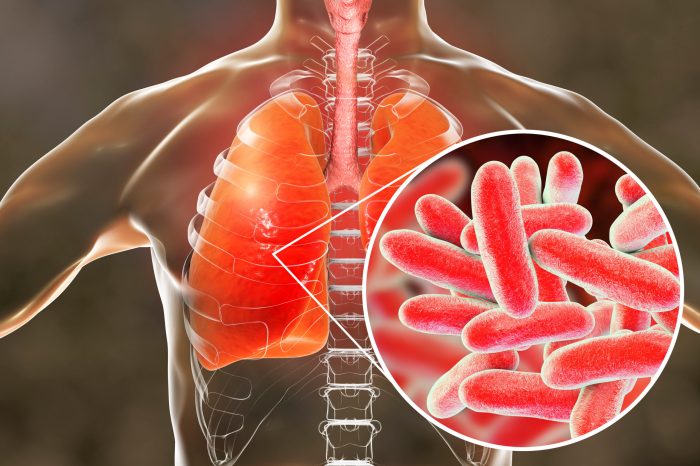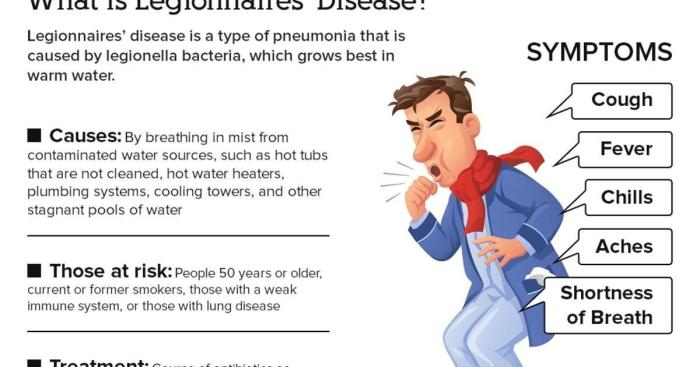What is legionnaires disease – Legionnaires’ disease, a severe lung infection caused by bacteria, poses significant health risks. This guide delves into its causes, symptoms, diagnosis, treatment, and prevention, providing comprehensive insights for understanding and managing this condition.
Legionella bacteria, the culprit behind Legionnaires’ disease, thrive in warm, stagnant water environments, such as cooling towers, hot tubs, and showerheads. Understanding the transmission modes and risk factors is crucial for preventing infection.
Overview of Legionnaires’ Disease
Legionnaires’ disease is a severe form of pneumonia caused by the bacteria Legionella pneumophila. It was first identified during an outbreak among attendees of an American Legion convention in Philadelphia in 1976, hence its name.
Legionnaires’ disease is a potentially fatal illness, but it can be treated with antibiotics if diagnosed early. The bacteria are commonly found in water systems, such as cooling towers, hot tubs, and showers, and can be spread through aerosolized water droplets.
Causes and Transmission
Bacteria
Legionnaires’ disease is caused by the bacteria Legionella pneumophila, which is a Gram-negative, rod-shaped bacterium.
Legionellabacteria are found naturally in water environments, such as lakes, rivers, and soil. They can also grow in man-made water systems, such as cooling towers, hot tubs, and showers.
Transmission, What is legionnaires disease

Legionnaires’ disease is spread through the inhalation of aerosolized water droplets that contain Legionellabacteria.
Common sources of Legionellabacteria include:
- Cooling towers
- Hot tubs
- Showers
- Misting systems
- Fountains
- Decorative water features
Risk Factors and Populations at Risk
Anyone can get Legionnaires’ disease, but some people are at higher risk than others.
Risk factors for Legionnaires’ disease include:
- Age 50 or older
- Smoking
- Chronic lung disease
- Weakened immune system
- Recent travel
- Exposure to contaminated water sources
Symptoms and Diagnosis

Symptoms

The symptoms of Legionnaires’ disease can vary, but they typically include:
- Fever
- Chills
- Muscle aches
- Headache
- Fatigue
- Cough
- Shortness of breath
- Confusion
- Diarrhea
- Nausea
- Vomiting
Diagnosis
Legionnaires’ disease can be diagnosed with a variety of tests, including:
- Chest X-ray
- Sputum culture
- Urine antigen test
- Blood test
Treatment and Prevention
Treatment
Legionnaires’ disease is treated with antibiotics.
The type of antibiotic used will depend on the severity of the infection.
Prevention
There are a number of things that can be done to prevent Legionnaires’ disease, including:
- Maintaining water systems at the proper temperature
- Cleaning and disinfecting water systems regularly
- Avoiding exposure to contaminated water sources
- Getting vaccinated against Legionnaires’ disease
Environmental Control and Management
Environmental control is essential for preventing Legionnaires’ disease.
Strategies for environmental control include:
- Maintaining water systems at the proper temperature
- Cleaning and disinfecting water systems regularly
- Using filters to remove Legionellabacteria from water
- Installing ultraviolet light systems to kill Legionellabacteria
Related Diseases and Conditions: What Is Legionnaires Disease
Legionnaires’ disease is a type of pneumonia.
Other types of pneumonia include:
- Streptococcal pneumonia
- Pneumococcal pneumonia
- Viral pneumonia
- Aspiration pneumonia
Concluding Remarks
Legionnaires’ disease, while serious, can be effectively managed with prompt diagnosis and treatment. Implementing preventive measures, including proper water system maintenance and environmental control, is essential to minimize the risk of infection. By raising awareness and promoting best practices, we can combat this disease and protect public health.
FAQ Section
What are the common symptoms of Legionnaires’ disease?
Symptoms include fever, chills, muscle aches, headache, and shortness of breath.
Who is at risk of contracting Legionnaires’ disease?
Individuals over 50, smokers, and those with weakened immune systems are at higher risk.
How is Legionnaires’ disease diagnosed?
Diagnosis involves urine or sputum tests to detect Legionella bacteria.
What is the treatment for Legionnaires’ disease?
Antibiotics are the primary treatment, and early diagnosis is crucial for effective recovery.
How can Legionnaires’ disease be prevented?
Regular cleaning and disinfection of water systems, maintaining proper water temperature, and using filters can minimize the risk of infection.